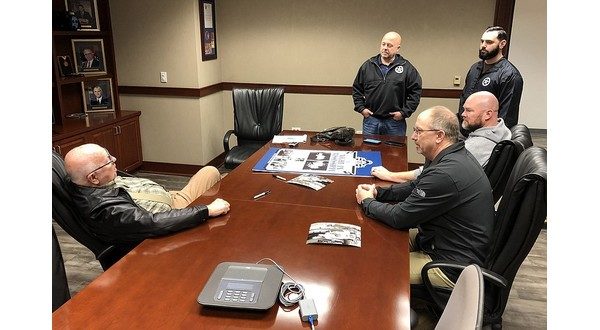
Former U.S. Deputy Marshal Herschel Garner (left) visits with other deputy marshals at the federal courthouse in Little Rock last month. (Photo courtesy of Arkansas Democrat-Gazette)
In 1954, a unanimous decision by the U.S. Supreme Court in the case of Brown v. Board of Education of Topeka, Kan., outlawed the segregation of schools in the U.S. by race and ushered in an era in Civil Rights that reverberates nearly 70 years later.
But desegregation didn’t happen overnight and, in fact, took years to implement, during which time the U.S. was rocked by protests as efforts to dismantle the “separate but equal” doctrine that had prevailed since the 1896 Supreme Court ruling in Plessy v. Ferguson declared racially segregated facilities were legal met with determined — and often deadly — resistance.
Herschel Garner, a native of Rison, was a newly minted deputy U.S. marshal in 1960 when he was ordered to go to New Orleans for a temporary assignment that provided him a front row seat to history even as it made him a participant in some of those events.
Last month, Garner, 85, was in Little Rock to record a podcast with Deputy U.S. Marshal Jeremy Hammons and U.S. Marshals Service historian Dave Turk, author of “Forging the Star: The Official Modern History of the United States Marshals Service,” to talk about his experiences during the early ’60s. It was part of the podcast series, “Chasing Evil.”
When Garner arrived in New Orleans, he had received only two weeks’ training in riot control, marksmanship and instruction in filling out the necessary government forms. The next year, he said, he attended the same two-week course a second time.
“It may have been planned to put me in riot control training because they anticipated that kind of duty would be coming up,” Garner said. “But that was all the law enforcement training I received outside of basic training in the Army.”
All other training at that time, he said, came on-the-job under the tutelage of a more experienced deputy marshal.
In November of 1960, with about six months’ experience as a deputy U.S. marshal, Garner said he was one of eight deputies sent to New Orleans to provide security for four 6-year-old Black girls who would be the first to integrate the schools in the city.
Garner was assigned to the security detail escorting Leona Tate, Gail Etienne and Tessie Prevost into McDonogh 19 Elementary School amid a backdrop of white parents and students resisting the effort. Altogether, he spent four weeks on the detail, which he said was far more peaceful than he had expected, mainly due to the presence of a large contingent of New Orleans police.
“I was pleasantly surprised that there was no violence when we went to the schools,” he said. “Our leaders may have known the New Orleans police were going to support us but the troops, the boots on the ground, didn’t know. I was fully expecting violence.”
As the deputies and their charges arrived at McDonogh 19 on that first day, Garner said, a line of New Orleans police had formed a barrier around the school, holding a crowd of enraged protesters back across a boulevard that ran in front of the school. As soon as the three girls entered the school, he said, parents of the white students there began checking their children out of school until by the end of the week only one white student was left.
“She didn’t come back the next week,” he said.
In May of 1961, Garner said, he was sent to Montgomery, Ala., to provide security for Martin Luther King Jr., who was there in support of freedom riders attempting to travel from Washington, D.C., to New Orleans. On the evening of May 21, King planned to address a gathering in the Rev. Ralph Abernathy’s First Baptist Church.
The previous day, when the freedom riders arrived in Montgomery, they were viciously attacked by a mob of hundreds of white people armed with bats, hammers, and pipes. That attack prompted the emergency deployment of a contingent of experienced deputies with riot training to reinforce the allotted personnel already there in the event of violence at the church service.
Garner said the deputies assembled at Maxwell Field in Montgomery, were loaded into mail trucks and transported to a vacant lot across from the church.
“We got there and a crowd of people were gathering around the church,” he said. “We knew what to do so we just lined up in front of the church and moved the crowd away.”
As the evening wore on, he said, the crowd got more violent, setting a couple of cars on fire and attempting to burn the church. After the arrival of local police and National Guard troops, the rioters were finally dispersed.
In 1962, Garner was sent to Oxford, Miss., to protect James Meredith, the first Black student to enroll in the University of Mississippi, where he faced the most harrowing duty of his career to that point. During the melee that followed, two people died and at least 166 were injured, according to the U.S. Marshals Service.
In September 1962, its legal maneuverings exhausted, Ole Miss was ordered by the federal courts to admit Meredith to the university. Garner said that when he and 126 other deputies assembled in Memphis for the flight to Oxford, some of the deputies balked at flying.
“Some of the deputies had never flown and were afraid to fly or didn’t want to,” he said. “They told us they were going to load the planes to see where everyone would sit so when we got out there they loaded up, shut the doors, cranked the engines and what we thought was going to be a dry run turned out to be the actual flight.”
At Oxford, Garner said, the deputies were loaded onto open-bed troop carriers and were transported to the Lyceum where they encountered hundreds of angry protesters throwing bricks, bottles and other objects.
“At some point,” he said, “somebody set an Army truck on fire … and we got the order to start using tear gas.”
Garner said a contingent of Mississippi state troopers were pulled back from the campus at that point and from there, “the situation just got worse and worse.”
“We had people shot,” he said. “One U.S. deputy marshal was shot in the neck and he was bleeding pretty profusely. He was put into a helicopter or a plane and flown back to Memphis … A lot of people were hurt. A newsman standing 25 feet from me was shot in the back with two shotgun pellets … It was a superficial injury but it was a gunshot wound.”
Garner said he and other deputies could hear shotgun pellets whizzing through the trees over their heads throughout the night and the only way they could hold the crowds at bay was by throwing tear gas canisters.
“Fortunately, I didn’t get hurt but a lot of guys did,” he said. “There were bricks and bottles flying through the air and it was dark so you couldn’t see and there was no way to dodge or to take cover.”
It was only after the arrival of the Army’s 101st Airborne that the riot was put down and Meredith was enrolled.
A week after the Dec. 12 recording of the segment of “Chasing Evil” that outlined Garner’s experiences, the former chief deputy was back in Little Rock to drop by the current U.S. Marshal’s office in Little Rock, where he met with deputies and signed copies of a photo taken of him and two other deputies escorting the three little girls at McDonogh 19 some 60 years previously.
Although he spent 30 years as a deputy U.S. marshal, Garner said he never intended to go into law enforcement as a career, but more as a way of supporting himself while he figured out what he wanted to do next.
“I had a course in criminology I took in college and I found it interesting,” he said. “I had planned to go into some kind of business with no definite plans but I took the criminology course and that got me interested in law enforcement.”
He soon learned of an opening in the U.S. Marshal’s office in Little Rock so he went in to visit with U.S. Marshal Richard Beal Kidd Jr. to see if he met the qualifications. He said Beal — who wound up being the first of six U.S. marshals he would serve under over the course of 30 years — was looking for a younger person for the team.
“In those days a lot of the deputies were retired from some other agency when they came to the marshals,” he said.
With the exception of special assignments, Garner said, his entire 30-year career was spent in Little Rock, 20 of those years as chief deputy.
“In those days they tended to hire local people into the marshal’s office,” he said. “When the chief deputy position opened up I was able to get promoted into that position. Otherwise, I would have had to have moved to a bigger city or to the Marshal’s Service headquarters or somewhere else to get a promotion.”
WebReadyTM Powered by WireReady® NSI










